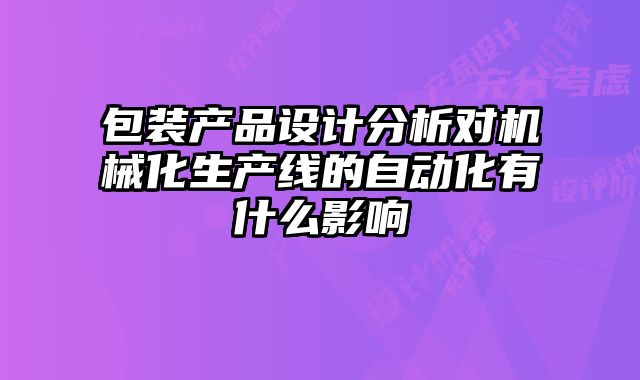包装产品设计是整个生产流程中不可或缺的一环,其设计理念和细节直接影响着机械化生产线的自动化程度和效率。合理的设计能够有效提升生产效率,降低生产成本,并为企业带来更多效益。以下从几个方面分析包装产品设计对机械化生产线的自动化影响:
包装产品结构的复杂程度直接影响着自动化生产线的可行性和成本。结构简单的产品更容易实现自动化,例如,标准化的箱体或袋装产品可以方便地进行自动包装、码垛和运输。而结构复杂的异形产品则需要定制化的机械设备和复杂的控制程序,自动化成本也相对较高。因此,在产品设计阶段,需要充分考虑产品的结构特点,以便为自动化生产线提供合理的设计方案。
包装材料的选择对生产效率有着直接的影响。例如,易于拆解的包装材料可以提高自动拆包、分拣和处理的速度。同时,材料的强度和抗压性也是需要考虑的因素,例如,用于自动码垛的包装箱需要具备足够的抗压能力,以保怔在运输过程中不会发生损坏。

产品的尺寸和形状决定了自动化的设备选择和生产线的布局。对于尺寸一致的产品,可以采用标准化的生产线,例如自动包装线、自动运输线等。而对于尺寸不一的异形产品,则需要采用可调节的设备和灵活的生产线布局。例如,可以利用工业机器人或机械手来完成产品的抓取、搬运和包装等操作。
产品的重量对自动化搬运设备的选择至关重要。轻型产品可以使用轻型机器人或传送带进行搬运,而重型产品则需要采用更强力的搬运设备,例如自动上下料设备、码垛机等。在设计阶段,需要充分考虑产品的重量,并选择合适的搬运设备,以确保生产效率。
产品的表面特性,例如材质、光滑度、纹理等,也会影响到自动化生产的精度。例如,光滑的表面更容易进行自动识别和定位,而粗糙的表面则需要更复杂的识别系统。同时,一些特殊的产品,例如易碎品,需要采用柔性抓取技术,以避免在搬运过程中发生损坏。
包装形式的选择对自动化的流程设计有着直接的影响。例如,袋装产品可以采用自动封口机进行包装,而箱装产品则需要使用自动封箱机。不同的包装形式需要不同的自动化设备和流程,因此在设计阶段需要充分考虑产品的包装形式,并制定合理的自动化方案。
产品质量控制是生产过程中不可缺少的一环。在自动化生产线上,可以通过集成自动化检测设备来提高产品质量检测效率。例如,可以通过视觉检测系统来识别产品外观缺陷,可以通过重量检测系统来检测产品重量是否符合标准。
自动化生产线可以收集大量的生产数据,例如生产速度、产品合格率、设备运行状态等。通过对这些数据的分析和利用,可以不断优化生产流程,提高生产效率,降低生产成本。
包装产品设计对机械化生产线的自动化程度和效率有着重要影响。在产品设计阶段,需要充分考虑产品的结构、材料、尺寸、重量、表面特性、包装形式以及质量控制等因素,并根据实际情况选择合适的自动化设备和流程。通过合理的包装产品设计,可以有效提升生产效率,降低生产成本,为企业带来更多效益。
如果您正在寻找自动化解决方案,例如自动码垛输送线、自动包装线、自动运输线、自动上下料、工业机器人、机械手、码垛机等,欢迎联系江苏斯泰克智能制造有限公司。斯泰克智能制造有限公司拥有专业的研发团队和丰富的经验,可以为您的企业提供定制化的自动化解决方案,帮助您实现生产效率的提升和成本的降低。
内容声明:本文内容由互联网收集,不代表本企业意见,本站不拥有内容中可能出现的商标、品牌所有权,不承担相关法律责任。如发现有侵权/违规的内容, 联系QQ670136485,邮箱:670136485@qq.com本站将立刻清除。